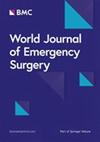Cumulative intra-abdominal pressure exposure and dynamic trajectories in ICU-admitted patients reveal prognostic determinants of severe acute pancreatitis
IF 5.8
1区 医学
Q1 EMERGENCY MEDICINE
引用次数: 0
Abstract
Intra-abdominal pressure (IAP) critically drives organ failure progression in severe acute pancreatitis (SAP). However, traditional static IAP monitoring inadequately captures dynamic injury evolution. This study aimed to assess the impact of cumulative IAP exposure (CumIAP) and dynamic trajectories on the prognosis of SAP. This retrospective cohort study analyzed 1,008 ICU-admitted SAP patients from the Jiangxi cohort (2005–2023) and 83 from MIMIC-IV (2008–2019). CumIAP was quantified via time-weighted integration of serial IAP measurements. Multivariate Cox regression models and restricted cubic splines (RCS) were established to analyze the dose–response relationships between CumIAP and death, infectious pancreatic necrosis (IPN), and persistent multiple organ failure (PMOF). Mediation analysis evaluated CumIAP’s role in albumin (ALB)- and acute necrotic collection (ANC)-associated outcomes. Latent class growth mixture model (LCGMM) was employed to identify dynamic IAP trajectory subtypes, and the associations between each trajectory group and poor prognosis were analyzed. Over a median inpatient follow-up of 17 days in the Jiangxi cohort, 200 (19.8%) patients died in hospital, while 208 (20.6%) and 329 (32.6%) developed IPN and PMOF, respectively. Regression analysis revealed that for each standard deviation increase in CumIAP, the risks of in-hospital death and PMOF increased by 37% and 86%, respectively, and there was a U-shaped association with the risk of IPN (P for nonlinearity = 0.004). Mediation analysis showed that CumIAP mediated 24.26% and 33.76% of the associations between ALB, ANC, and the risk of in-hospital death, respectively. Three IAP trajectories were identified by LCGMM: the high-pressure rapid decline group (HRD-T1), the low-pressure gradual decline group (LGD-T2), and the low-pressure progressive increase group (LPI-T3). Among them, compared with HRD-T1 and LGD-T2, the subjects in the LPI-T3 group had a significantly increased risk of adverse clinical outcomes. This is the first study to revealed that CumIAP is linearly positively correlated with death and PMOF, while exhibits a U-shaped relationship with IPN. Notably, patients with low baseline IAP and a rising trajectory exhibited worse outcomes than those with high baseline IAP and a declining trend. This is the first study to introduce CumIAP as a quantitative metric to assess the early IAP burden and its prognostic significance in SAP, overcoming the limitations of static IAP monitoring. RCS and regression analyses revealed a positive linear association between CumIAP and in hospital mortality/PMOF, and a U-shaped relationship with IPN, suggesting the possible presence of a risk threshold. LCGMM identified three IAP trajectory patterns; the "low baseline with rising trend" group (LPI-T3) had the worst outcomes, underscoring the value of dynamic over static IAP monitoring. Mediation analysis showed that CumIAP partly mediated the effects of hypoalbuminemia and ANC on outcomes, suggesting that IAP might represent an important intermediary pathway and a therapeutic target in SAP.重症监护病房住院患者的累积腹内压暴露和动态轨迹揭示了严重急性胰腺炎的预后决定因素
腹内压(IAP)是严重急性胰腺炎(SAP)患者器官衰竭进展的关键驱动因素。然而,传统的静态IAP监测无法充分捕捉到损伤的动态演变。本研究旨在评估累积IAP暴露(CumIAP)和动态轨迹对SAP预后的影响。本回顾性队列研究分析了来自江西队列(2005-2023)的1008例icu住院SAP患者和来自MIMIC-IV(2008-2019)的83例患者。通过一系列IAP测量的时间加权积分来量化CumIAP。建立多变量Cox回归模型和限制性三次样条(RCS)分析CumIAP与死亡、感染性胰腺坏死(IPN)和持续性多器官衰竭(PMOF)之间的剂量-反应关系。中介分析评估了CumIAP在白蛋白(ALB)和急性坏死收集(ANC)相关结果中的作用。采用潜类生长混合模型(Latent class growth mixture model, LCGMM)识别IAP动态轨迹亚型,并分析各轨迹组与不良预后的关系。在江西队列中位17天的住院随访中,200例(19.8%)患者在医院死亡,208例(20.6%)和329例(32.6%)患者分别发生IPN和PMOF。回归分析显示,CumIAP每增加一个标准差,院内死亡和PMOF的风险分别增加37%和86%,与IPN的风险呈u型相关(非线性P = 0.004)。中介分析显示,CumIAP分别介导了24.26%和33.76%的ALB、ANC与院内死亡风险之间的关联。LCGMM识别出三种IAP轨迹:高压快速下降组(HRD-T1)、低压逐渐下降组(LGD-T2)和低压逐渐增加组(LPI-T3)。其中,与HRD-T1和LGD-T2相比,LPI-T3组受试者出现临床不良结局的风险显著增加。这是首次发现CumIAP与死亡和PMOF呈线性正相关,而与IPN呈u型关系。值得注意的是,基线IAP低且呈上升趋势的患者比基线IAP高且呈下降趋势的患者表现出更差的结果。这是首次引入CumIAP作为定量指标来评估SAP早期IAP负担及其预后意义的研究,克服了静态IAP监测的局限性。RCS和回归分析显示,CumIAP与院内死亡率/PMOF呈正线性关系,与IPN呈u型关系,表明可能存在风险阈值。LCGMM确定了三种IAP轨迹模式;“低基线有上升趋势”组(LPI-T3)的结果最差,强调了动态IAP监测比静态IAP监测的价值。中介分析显示,CumIAP在一定程度上介导了低白蛋白血症和ANC对预后的影响,表明IAP可能是SAP的一个重要中介途径和治疗靶点。
本文章由计算机程序翻译,如有差异,请以英文原文为准。
求助全文
约1分钟内获得全文
求助全文
来源期刊

World Journal of Emergency Surgery
EMERGENCY MEDICINE-SURGERY
CiteScore
14.50
自引率
5.00%
发文量
60
审稿时长
10 weeks
期刊介绍:
The World Journal of Emergency Surgery is an open access, peer-reviewed journal covering all facets of clinical and basic research in traumatic and non-traumatic emergency surgery and related fields. Topics include emergency surgery, acute care surgery, trauma surgery, intensive care, trauma management, and resuscitation, among others.
 求助内容:
求助内容: 应助结果提醒方式:
应助结果提醒方式:


